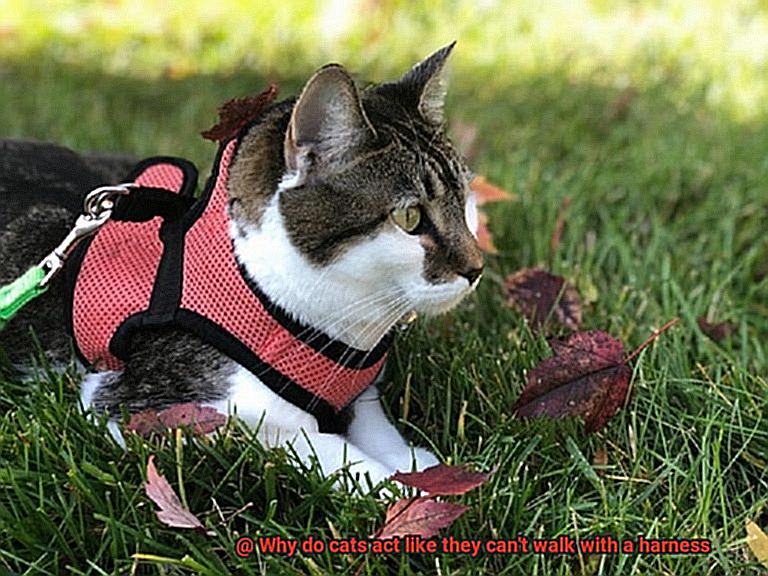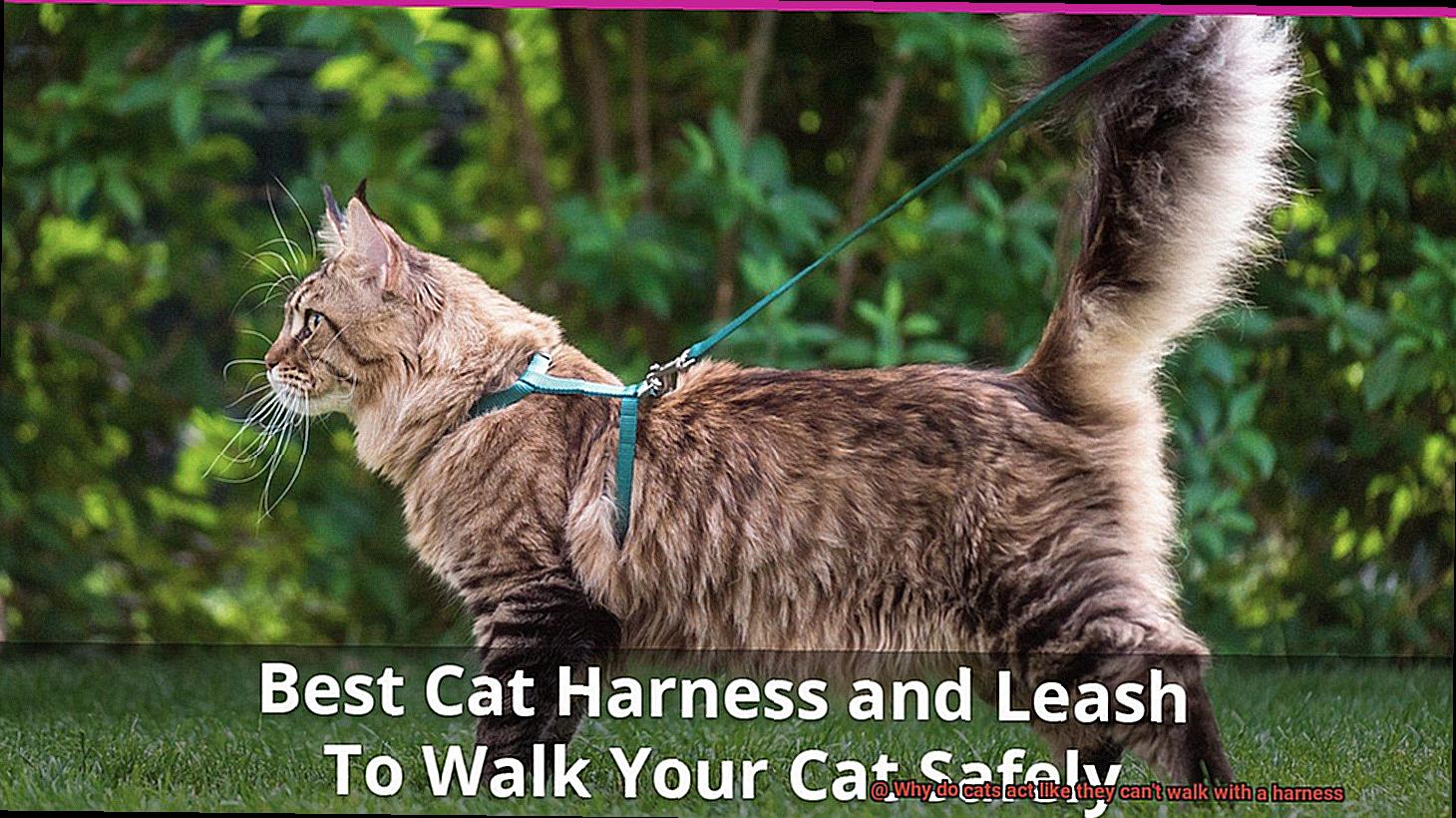Do you dream of taking your cat on a peaceful walk outside, only to be met with resistance and frustration when trying to put on a harness? Fear not, as you are certainly not alone. It’s a common misconception that all cats can be trained to walk on a harness, but the truth is that some cats simply don’t enjoy the feeling of being restrained.
As an expert in feline behavior, I can tell you that there are several reasons why cats may act like they can’t walk with a harness. For starters, cats are natural explorers and hunters. They’re used to being able to move swiftly and silently without any hindrance. When you put a harness on them, it restricts their movements and makes them feel vulnerable. Additionally, cats have a strong sense of territory and may feel threatened when taken outside of their familiar environment on a leash.

Another reason is that cats are creatures of habit and routine. They like to stick to their own schedules and don’t always appreciate the disruption of being taken for a walk. Plus, let’s face it- some cats are just plain stubborn. They may resist the harness simply because they don’t want to do what you’re asking of them.
So what can you do if your cat refuses to cooperate with the harness? Don’t worry- we’ve got you covered. In this blog post, we’ll be exploring some tips and tricks for getting your feline friend comfortable with wearing a harness and leash. Whether you’re looking to take your cat on outdoor adventures or just want them to get used to wearing a harness for safety reasons, we’ve got plenty of advice that will help make the transition smoother for both you and your furry companion.
What is a Harness?

A harness is a piece of equipment that wraps around your cat’s body and attaches to a leash, providing a secure way to take your cat for a walk outside. There are different types of harnesses available, including vest-style and figure-eight style.
Vest-style harnesses are made of soft materials like nylon or mesh and wrap around the cat’s body like a vest. Figure-eight harnesses consist of two loops – one that goes around the cat’s neck and another that goes around the chest. Regardless of which type you choose, a harness should fit snugly but not be too tight or too loose. It should be adjusted so that it does not rub against the cat’s skin or restrict their movement.
Why is a harness important for your cat’s safety? Unlike collars, which can easily slip off or cause injury if the cat pulls too hard, a harness distributes pressure evenly over their body, reducing the risk of injury. This is especially important in areas with lots of traffic or other potential hazards.
But a harness isn’t just about safety- it can also provide mental stimulation for your curious feline. A walk on a harness can expose them to new sights, sounds, and smells, keeping them engaged and entertained.
However, getting your cat accustomed to wearing a harness may take patience. Some cats may resist due to discomfort or fear. That’s why it’s crucial to choose the right size and type of harness for your cat to ensure they are comfortable and can move freely while wearing it.
Sensitivity to Touch and Pressure
This can make it challenging for them to adapt to wearing a harness, which can cause discomfort and lead them to resist walking with the harness altogether.
One of the reasons why cats might struggle with wearing a harness is due to their sensitive fur. The pressure of the harness on their body can pull on their fur and cause discomfort or pain, making it difficult for them to adjust to the feeling. Additionally, cats are naturally independent creatures and may feel restricted by the harness, leading them to resist movement.
But don’t worry, there are ways you can help your cat adjust to wearing a harness. First, it’s important to choose the right harness. Look for one that is designed specifically for cats and made with comfortable materials that won’t irritate their skin or fur.
Once you have the right harness, it’s time to introduce it gradually. Begin by placing the harness on your cat for short periods while they are relaxed and calm. This will help them get used to the feeling of wearing it without overwhelming them.
Positive reinforcement is also crucial when training your cat to wear a harness. Reward them with treats or praise when they wear the harness without resistance. This will help them associate the harness with positive experiences and make them more likely to wear it willingly in the future.
Lastly, be patient and persistent in training your cat to wear a harness. Remember that each cat is unique and may take longer to adjust to wearing a harness. But with patience and understanding, you can help your feline friend overcome their reluctance and safely enjoy exploring the outdoors.
Restriction of Movement
They have an independent nature and are sensitive to anything that may restrict their movement. This is why your cat may act like they can’t walk with a harness on. Let’s explore the reasons why.
First, cats want to be able to move around freely and explore their environment without any restrictions. Wearing a harness can make them feel vulnerable and exposed, triggering their natural fight or flight response. They may freeze or try to escape from the harness, making it difficult for them to walk or move comfortably.
Secondly, cats are creatures of habit. Any changes to their routine or environment can cause them stress and anxiety. Introducing the harness gradually and allowing your kitty to get used to it before attempting to take them for a walk is crucial. It’s also important to provide positive reinforcement such as treats or praise when they wear the harness without any fuss.
So, how can you help your feline friend overcome their reluctance and safely enjoy exploring the great outdoors? Here are some tips:
- Introduce the harness gradually and let your cat get used to wearing it indoors before taking them outside.
- Provide positive reinforcement when they wear the harness without any fuss.
- Ensure that the harness fits properly and is not too tight or too loose.
- Choose a quiet and safe outdoor location for your first walks together.

Fear and Anxiety
However, the reality of the situation might be far from what you envisioned. Instead, you are faced with a cat that freezes up or tries to escape from the harness. But fear not, as this is a common issue that many cat owners face, and it can be overcome with patience and understanding.
Fear and anxiety are the primary culprits behind a cat’s reluctance to walk with a harness. Cats are cautious creatures by nature, and introducing them to a new experience like walking on a leash can be daunting for them. Moreover, negative past experiences such as vet visits or being confined in a carrier can make cats apprehensive about anything that restricts their movement.
When it comes to walking with a harness, fear and anxiety can manifest in different ways in cats. Some might freeze up and refuse to move, while others may try to wriggle out of the harness or become overly vocal. It’s essential to recognize these signs and take steps to alleviate your cat’s fears.
The key to helping your cat overcome their fear of walking with a harness is taking things slow and introducing the harness gradually. Start by allowing your cat to investigate and sniff the harness while it’s still on the ground. Then, gradually work up to wearing it for short periods of time indoors. Positive reinforcement such as treats or praise can also help your cat associate the harness with good things.
Choosing a well-fitting harness that isn’t too tight or restrictive is also crucial. A poorly fitting harness can increase feelings of anxiety in your cat and make them more resistant to wearing it.
To summarize, fear and anxiety can be significant obstacles when it comes to walking with a harness, but they can be overcome with patience, understanding, and positive reinforcement. Here are some tips that can help:
- Introduce the harness gradually
- Use positive reinforcement
- Choose a well-fitting harness

How to Introduce a Cat to a Harness
The key to success is to take things slow and be patient. Here are some tips on how to introduce your cat to a harness:
Choose the Right Harness
The first step is crucial – choosing the right harness for your cat. A harness should fit snugly but not be too tight or restrictive. There are several types of harnesses available in the market, such as H-style, figure-8, and vest-style harnesses. It is important to choose a harness that suits your cat’s body type and temperament.
Introduce the Harness Slowly
After you’ve chosen the right harness, introduce it to your cat slowly. Allow your cat to sniff and explore the harness before attempting to put it on them. This will help them become familiar with it and reduce their fear of the unknown object. You can also try placing treats or food near the harness to create a positive association.
Put the Harness on Your Cat Gradually
Once your cat is comfortable with the presence of the harness, it’s time to start putting it on them. Begin by placing the harness loosely around your cat’s neck. Allow your cat to sniff and explore the harness while giving them lots of praise and treats. This will help them associate the harness with positive experiences.
Adjust the Harness
Next, fasten the harness around your cat’s neck and adjust it to fit snugly but not too tightly. Check that you can still fit two fingers between your cat and the harness. Once your cat is comfortable wearing the harness around their neck, you can begin attaching the leash.
Start Walking Inside Your Home
Attach the leash to the harness and allow your cat to get used to the sensation of being tethered. Begin by walking around inside your home, letting your cat lead you while still providing lots of praise and treats. This will help your cat get used to the feeling of being on a leash and build their confidence.
Be Patient and Persistent
Introducing a cat to a harness takes time and patience. Never force your cat to wear a harness or take them outside if they are uncomfortable. This can cause them to become scared and anxious, making the process even more difficult. With consistent positive reinforcement, most cats can learn to walk comfortably on a harness and enjoy exploring the outdoors with their owner.
Tips for Making the Harness Experience More Enjoyable
Trying to get your cat used to wearing a harness can be a challenge, but it doesn’t have to be a stressful experience. The key is to approach the process with patience and positivity. Here are some tips for making the harness experience more enjoyable for both you and your feline friend.
Start Slow
Introducing a harness to your cat can be overwhelming, so it’s important to start slow. Allow your cat to sniff and explore the harness while it’s laying on the ground before putting it on them. Once they seem comfortable with it, try putting the harness on for short periods of time while indoors. Gradually increase the amount of time they wear the harness until they become comfortable wearing it for longer periods.
Use Positive Reinforcement

Rewarding your cat with treats or praise when they show interest in the harness or wear it without fussing can help create positive associations with the harness. This will make them more willing to wear it again in the future.
Choose the Right Fit
A well-fitting harness is essential for your cat’s comfort and safety. Be sure to measure your cat’s girth accurately and choose a harness that is snug but not too tight. This will allow your cat plenty of room to move around comfortably.
Let Your Cat Lead
When walking your cat on a harness, let them lead the way and explore at their own pace. Avoid pulling or tugging on the leash, as this can cause discomfort and stress for your pet.
Be Patient

It’s important to remember that every cat is different, and some may take longer to get used to wearing a harness than others. If your cat is clearly uncomfortable or resistant, don’t force them to wear the harness. Instead, take things at their pace and be patient. With time, most cats can learn to love their harness and enjoy walks outdoors.
Finding the Right Fit for Your Cat’s Harness
Taking your cat for a walk can be a fun and enjoyable experience for both you and your furry friend. However, finding the right fit for your cat’s harness is crucial to ensure their comfort and safety while exploring the outdoors. Let’s dive into the importance of finding the perfect harness fit for your cat.
Comfort is Key
Just like humans, cats need to feel comfortable in their clothes. A harness that is too tight can cause irritation or even harm, while a harness that is too loose may allow your cat to escape or become entangled. Measuring your cat’s chest and neck before purchasing a harness is crucial to ensure the perfect fit.
Choose the Right Material
The material of the harness is just as important as the fit. Some cats may have sensitive skin, so it’s essential to choose a harness made from soft and comfortable material that won’t irritate their skin. A relaxed cat makes for a happy cat.
Introduction is Key
Introducing a harness to your cat can be challenging, but it’s essential to do so gently and slowly. Let your cat sniff and investigate the harness while it’s on the ground before putting it on them. When you’re ready to put the harness on, do so gently and slowly, making sure not to pull too tightly or cause any discomfort.
Positive Reinforcement
Positive reinforcement is an excellent way to encourage your cat to wear a harness comfortably. Give them treats and praise when they have the harness on, so they associate it with positive experiences. This will help them feel more confident and relaxed while wearing it.
Supervision is Crucial
Always supervise your cat while they are wearing a harness and never leave them unattended outside. Cats are curious creatures, and they may try to escape or get themselves into trouble. Therefore, it’s crucial always to keep an eye on them while they’re exploring the great outdoors.
Positive Reinforcement Techniques
However, introducing your cat to the world of harnesses can be a daunting task. Luckily, positive reinforcement techniques are a powerful tool that can help your cat feel comfortable and confident while wearing a harness.
To begin with, it’s crucial to start slowly when introducing your cat to a harness. Allow them to sniff and inspect the harness, then offer praise or treats for good behavior. Gradually increase the amount of time they wear the harness until they become more comfortable.
Distractions are also an excellent way to keep your cat occupied while they’re wearing their harness. Toys, treats, and playtime can help reduce any anxiety they may feel. Remember that every cat is different and what works for one may not work for another. So, patience and persistence are key when training your cat.
Treats are another great way to encourage positive behavior in your cat. Offer them as a reward when they walk calmly with the harness or allow you to put it on without resistance. Verbal praise is also an effective form of positive reinforcement, so make sure to offer lots of affection when your cat does something right.
With these positive reinforcement techniques, even the most hesitant cats can learn to enjoy walks with a harness. Just remember to supervise them during outdoor adventures and ensure that the harness fits correctly and is made from soft material that won’t irritate their skin.
ERllZYZuaOE” >
Conclusion
In conclusion, walking your cat with a harness can be a rewarding experience for both you and your feline friend. As an expert in feline behavior, I understand that cats may initially resist wearing a harness due to their natural instincts or fear of confinement.
To help your cat become comfortable with the idea of wearing a harness, it’s important to choose the right type of harness that fits well and is made from soft materials. Introducing the harness gradually and using positive reinforcement techniques such as treats or verbal praise can also make the training process more enjoyable for your cat.
While every cat is unique and may take longer to adjust to wearing a harness, don’t give up hope. With patience and persistence, most cats can learn to love their harnesses and enjoy walks outdoors.
Walking your cat on a harness not only provides mental stimulation but also ensures their safety from potential hazards outside.

